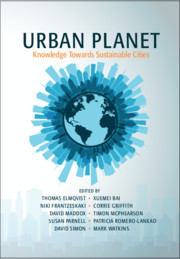17 results
Introduction: - Situating Knowledge and Action for an Urban Planet
-
-
- Book:
- Urban Planet
- Published online:
- 27 April 2018
- Print publication:
- 26 April 2018, pp 1-16
-
- Chapter
-
- You have access
- Open access
- HTML
- Export citation
Part II - Global Urban Sustainable Development
-
- Book:
- Urban Planet
- Published online:
- 27 April 2018
- Print publication:
- 26 April 2018, pp 147-260
-
- Chapter
-
- You have access
- Open access
- HTML
- Export citation
Contents
-
- Book:
- Urban Planet
- Published online:
- 27 April 2018
- Print publication:
- 26 April 2018, pp v-ix
-
- Chapter
-
- You have access
- Open access
- HTML
- Export citation
Tables
-
- Book:
- Urban Planet
- Published online:
- 27 April 2018
- Print publication:
- 26 April 2018, pp xv-xv
-
- Chapter
-
- You have access
- Open access
- HTML
- Export citation
Preface
-
- Book:
- Urban Planet
- Published online:
- 27 April 2018
- Print publication:
- 26 April 2018, pp xxi-xxx
-
- Chapter
-
- You have access
- Open access
- HTML
- Export citation
Synthesis - New Integrated Urban Knowledge for the Cities We Want
-
-
- Book:
- Urban Planet
- Published online:
- 27 April 2018
- Print publication:
- 26 April 2018, pp 462-482
-
- Chapter
-
- You have access
- Open access
- HTML
- Export citation
Chapter 1: - Global Urbanization
- from Part I - Dynamic Urban Planet
-
-
- Book:
- Urban Planet
- Published online:
- 27 April 2018
- Print publication:
- 26 April 2018, pp 19-44
-
- Chapter
-
- You have access
- Open access
- HTML
- Export citation
Figures
-
- Book:
- Urban Planet
- Published online:
- 27 April 2018
- Print publication:
- 26 April 2018, pp x-xiv
-
- Chapter
-
- You have access
- Open access
- HTML
- Export citation
Part I - Dynamic Urban Planet
-
- Book:
- Urban Planet
- Published online:
- 27 April 2018
- Print publication:
- 26 April 2018, pp 17-146
-
- Chapter
-
- You have access
- Open access
- HTML
- Export citation
Contributors
-
- Book:
- Urban Planet
- Published online:
- 27 April 2018
- Print publication:
- 26 April 2018, pp xvi-xx
-
- Chapter
-
- You have access
- Open access
- HTML
- Export citation
Part III - Urban Transformations to Sustainability
-
- Book:
- Urban Planet
- Published online:
- 27 April 2018
- Print publication:
- 26 April 2018, pp 261-350
-
- Chapter
-
- You have access
- Open access
- HTML
- Export citation
Copyright page
-
- Book:
- Urban Planet
- Published online:
- 27 April 2018
- Print publication:
- 26 April 2018, pp iv-iv
-
- Chapter
-
- You have access
- Open access
- HTML
- Export citation
Part IV - Provocations from Practice
-
- Book:
- Urban Planet
- Published online:
- 27 April 2018
- Print publication:
- 26 April 2018, pp 351-461
-
- Chapter
-
- You have access
- Open access
- HTML
- Export citation

Urban Planet
- Knowledge towards Sustainable Cities
-
- Published online:
- 27 April 2018
- Print publication:
- 26 April 2018
-
- Book
-
- You have access
- Open access
- Export citation
13 - Response strategy assessment: a tool for evaluating resilience for the management of social–ecological systems
-
-
- Book:
- Resilience and the Cultural Landscape
- Published online:
- 05 November 2012
- Print publication:
- 18 October 2012, pp 224-241
-
- Chapter
- Export citation
7 - Living with disturbance: building resilience in social–ecological systems
-
-
- Book:
- Navigating Social-Ecological Systems
- Published online:
- 13 August 2009
- Print publication:
- 17 October 2002, pp 163-186
-
- Chapter
- Export citation
Conserving Pacific Island flying foxes
-
- Article
-
- You have access
- Export citation



